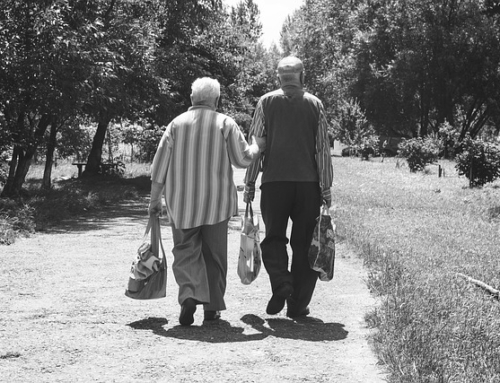Spring has arrived . . . at least here in Florida. We had mid-80s and sunshine last week. On the other hand, my son is in Boston, and they were under another eight inches of snow, although he did report the daytime temps were in the upper 40s, so he’s happy that he’s down to only one outer layer. It’s his first New England winter, and he loves above all things to be outside, so he has a serious case of cabin fever. Fresh air is a tonic. It restores our souls, connecting us with the Creator in a way few things can. That’s why more ministry should be “fresh air ministry”: from worship to Bible Study to fellowship, we should be getting out of the building as often as possible.
The move by churches to embrace more outdoor settings (both on and off their campuses) is a reflection of the growing body of scientific and medical research that indicates just how restorative some daily time in nature can be for our bodies and souls, as writer Jamie Ducharme summarizes in a recent article:
Spending time outdoors, especially in green spaces, is one of the fastest ways to improve your health and happiness. It’s been shown to lower stress , blood pressure and heart rate, while encouraging physical activity and buoying mood and mental health. Some research even suggests that green space is associated with a lower risk of developing psychiatric disorders — all findings that doctors are increasingly taking seriously and relaying to their patients.
Local churches can make a habit of moving some of their regular activities outside (like worship), create spaces that are tailored to encourage groups to do more outside (like Bible studies and support groups), and create spaces that invite the community to come to their property for outdoor activities (like dog parks, playgrounds, sports fields, and reflection gardens).
The benefits to congregations are many, as Danny Franks writes in Christianity Today:
There are several good reasons to take things outside. Church outside the norm brings excitement to your congregation. It stirs up stagnant waters and forces you out of ruts. If you’re a multi-service or multi-site church, this is an opportunity to get the entire family together under no roof.
There are also potential wins for outreach. Few things will bring outsiders and insiders closer together than taking insiders outside. Outdoor services allow your church to invite your community to a non-threatening, neutral environment. Neighbors may feel skeptical about walking into the sanctuary at First Baptist, but they’ll let down their defenses if they’re heading to the neighborhood park.
You can use the momentum of an outdoor event to bless your city by partnering with a local charity, or inviting attendees to bring food for the soup kitchen or blankets for the homeless shelter. You might lean into existing partnerships or ask your team to help forge new ones.
There are many specific ideas for hosting outdoor events (like in this article of 20 outdoor summer ideas from Lifeway):
- Cookout
- Outdoor worship
- Kite-flying
- Concert on the lawn
- Bicycle parade
- Outdoor movie night
- Drive-through snow cones (or ice cream)
- Drama or musical in the park
- VBS outside in the community
When researching ideas from other churches, some may immediately jump out as something you could emulate and make your own, while others won’t make much sense in your setting but may inspire variations that will work uniquely well for your context. (If you are new to the idea of hosting outdoor events, particularly worship, here are some good insights into how to successfully plan for a stress-free event.)
Some churches have started dedicated ministries that exist outside the “normal” walls of their church buildings. These initiatives recognize the ways in which traditional church buildings and trappings create anxiety for some people who would worship God in a setting that they find less fraught with emotional and philosophical baggage. These ministries are powerfully biblical in nature, capturing the sense of Jesus’ willingness to meet people in their own settings. One of the most famous ministries of this type is the Cathedral in the Night in Northampton, Massachusetts, a ministry of the Evangelical Lutheran Church in America. Stephanie Smith describes the vision and impact in her own words:
Each Christian tradition has a part of Jesus that they claim. The word radical comes from a Latin word for root. We say we’re in the radical tradition of Jesus, because we are rooted in doing what the gospels say he did—feed souls and bodies in outdoor settings. Also, Jesus was radical in whom he welcomed. When he said, “Let the children come to me,” we think, “Oh, how sweet.” But for his time that was radical. He was standing with the marginalized. At Cathedral in the Night, we’re creating community with everyone, because we are church together.
To walk through the door of a church, many people assume they have to agree with everything said to them inside. Outside, they can be skeptical or watch from afar. I’ve been a pastor in an indoor church. Unconsciously, we gave or received the message that we all had to be on the same page.
Being outside feels safer for many people experiencing homelessness or poverty. If there’s a fight, which rarely happens in our services, it’s easy to walk away. And nine times out of ten, if someone is ornery, they are hungry. So we offer food. They need to be fed and heard.
Outside, God has surprised us in how welcoming we can be.
Worship on the street is powerful. Worship in community parks can be as well. Worship with people and their pets is another option that is catching on in communities around the nation. And, of course, worship in non-traditional settings like the local pub has been with us for a while now.
Some of the ministries that are deeply connecting with people (both the regularly-churched and the non-churched) are outdoor activities that gather people together in settings in which the outdoor activity itself is the reason for the gathering – these can be either strictly a time of fellowship and sharing a love for the creation, or very often they mix in elements of prayer, study, or worship. Saddleback Church is one of many congregations that offer regular hiking groups. Los Angeles is also the location of an unusual congregation without walls that is built solely around hiking. It’s called, appropriately, The Hiking Church of West Los Angeles, and its membership hikes out to a remote destination in the California mountains every week and holds their worship service there.
For United Methodists, several of the projects in response to the church’s call for “Fresh Expressions” of faith have involved nature-oriented activities. One of those is “Kayaking with Jeff,” a ministry of Mandarin United Methodist Church in Jacksonville, Florida, in which folks join Rev. Jeffrey St. Clair on kayaking outings:
“Kayaking with Jeff” began in January 2016 when St. Clair, an avid kayaker, was constantly put on waiting lists for kayaking trips. After praying, he was led to start his own group. It was the same time he heard of the Fresh Expression movement to create new places for people – many of whom may be unchurched – to worship.
That first outing saw 15 kayakers begin their adventure in the water. Currently, St. Clair has 35-70 people join him on Saturdays. Adults and children see fish, eagles and dolphins and experience sunsets, fresh air and much more.
“Most importantly we have grown in faith and in community with each other,” said St. Clair.
St. Clair opens the group with prayer, scripture and a brief message and has conversations on the water with the kayakers.
The church partners with a local business that charges it low fees to rent kayaks and paddles.
The sky, literally, is the limit when it comes to options for taking ministry outside. It helps your regular people see things from a different and fun perspective. It helps the community see that you embrace the values of fresh air and aren’t so stuffy in their in your “churchy” spaces. How does your congregation creatively utilize the outdoor spaces on your campus? How does your congregation partner with the community to celebrate the great outdoors?








Leave A Comment